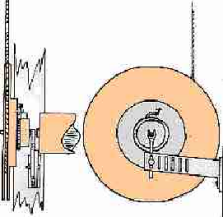- Home
- Resurrection ▾
-
Learn ▾
- Free library
- Glossary
- Documents
- Initiation
-
Shaped fabrics
- Introduction
- Popularization
- Definitions
- Le métier de façonné
- Principes du façonné
- Mécaniques de façonné
- Le jeu des crochets
- Les cartons
- Chaîne des cartons
- Mécanique 104 en détail
- Pour en finir
- Montage façonné
- Empoutage 1/3
- Empoutage 2/3
- Empoutage 3/3
- Punching, hanging and dip
- Autres façonnés
- Façonnés et Islam
-
Cours de tissage 1912
- Bâti d'un métier
- Le rouleau arrière
- Les bascules
- Formation du pas
- Position de organes
- Mécanique 104 Jacquard
- Fonctionnement 104
- Lisage des cartons
- Le battant du métier
- Le régulateur
- Réduction et régulateur
- Mise au métier d'une chaîne
- Mise en route du métier
- Navettes à soie
- Battage
- Ourdissage mécanique
- Préparation chaînes et trames
- Equipment ▾
- Chronicles ▾
- Fabrics ▾
- Techniques ▾
- Culture ▾
- Language ▾

The rear beam
The rear roller (beam) is a simple roller of wood about 50 cm in circumference at the ends of which are added (or are integral with the roller) 2 collars which will allow the braking by friction of a rope as we will see later. . At each end of the roller is crimped a round iron shaft protruding enough to be able to rest in the 2 roller supports attached to the rear feet. Different models of rear roller supports exist, most often in cast steel or steel.
The front beam
There, the solutions vary depending on the fabric to be made, but for our taffeta, the front beam will in fact be a set of 3 rolls working together. A main roll with a diameter of about 20 cm will be located at the very front, above the banks of the front legs. A round steel pin is crimped at each end to secure it. At the right end of this roller, a large toothed wheel is threaded on the metal axle and firmly fixed to the edge of the roller using 4 screws. This wheel, driven by the regulator wheel, will allow the rotation of the roller and therefore the training of the fabric and the unwinding of the chain (see below: regulator). The steel axe at the other end of the beam rests on a support fixed to the left upright (foot) of the frame A second beam of the same length but of smaller diameter (8 to 10 cm) is positioned behind the first, but a few centimeters lower.
Thus, the fabric will go around 2/3 of the circumference of the first beam, then pass over the second roll, also bypass it on 2/3, pass over a third roll of even smaller diameter and finally come to wind up on the magazine roller fixed under the frames, fairly close to the ground.
This path will prevent the fabric from slipping on the beams as they rotate. The second beam is usually driven by the first (using a pinion), while the third is free and looks more like a big rod than a actual roller (diameter about 3 cm).
The advantage of having three front beams rather than one is that if the fabric is wrapped around a single beam, the latter grows as you weave and the diameter varies, the speed of advance of the beam also varies. It is therefore often necessary to manually rectify the position of the facade which is constantly moving. We then act manually on the manual rotation handle of the regulator. This operating mode is less precise and the risk of tamping irregularity is greater. This can be tricky for certain fabrics which require exemplary packing consistency.
Single front beam = direct winding regulation
Multiple front beams = indirect winding regulation for fixed threshing.
The Savoyard store roll
The fabric is stored as it goes on the magazine roll placed at the front of the loom, at the bottom. It is a simple roller provided with a longitudinal embossing groove intended to accommodate an embossing rod whose mission is to wedge the beginning of the fabric before it is wound up. To ensure its rotation so that it "swallows" the fabric as it is woven, a simple cord wound on one edge and provided with a weight is sufficient. But to avoid having to rewind this rope constantly (since this roller is very close to the ground), we direct the rope towards the ceiling, then after having made it pass over a pulley, we attach a weight to it. This provides a comfortable path length of several meters. Before the weight reaches the ground, the rope is rewound around the roller to raise the weight. The Savoyard magazine roll has a large cheek at one end, on which this rope is wound. This cheek is mobile and can rotate freely around the axis of the roller. A cogwheel is attached to it, while a dog prevents it from unwinding. To rewind the rope, simply lift the hammer, turn the Savoyard, then put the hammer back in place.
Practical hand weaving course
Lyon Municipal Weaving SchoolProfessor A.CREPT - Year 1912-1913
The handwritten course has been copied by us.This hand weaving course on looms was used until the 1980s.
